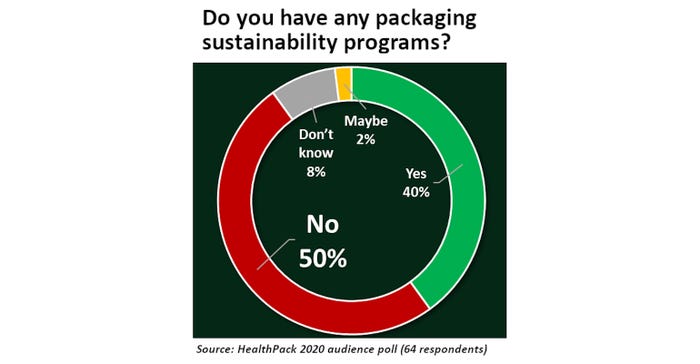Medical Device Packagers Want Greater Sustainability, But Unsure How to Get There: Gallery

Healthcare packaging might be behind from a sustainability point of view — when empty packages are in the same environment as human blood, safety supersedes recycling, as well it should. But the amount of packaging being recycled or the amount of recycled-content material in packages might change soon, if industry professionals, especially younger ones, turn their interest into action.
Attendees at the recent HealthPack 2020 shared their opinions on several topics in an audience poll. The slideshow shares the results of the four questions asked and answered regarding sustainability.
During the polling, a panel of medical packaging experts commented on the topics. One of the panelists, Ondrea Kassarjian, senior manager, Packaging & Labeling, at Hollister Inc., acknowledged the sustainability challenges for medical packaging.
“Sustainability is important. It’s on everybody’s radar. But in our industry, we have a lot of constraints on how to get there,” Kassarjian said. “We often think about material selection and configuration. But there’s really a full lifecycle for the product development and the supply chain that our products have, both from materials coming into our factories and finished goods out.”
Kassarjian continued, “It’s interesting … putting recycled materials in a sterile barrier package … I think most of us aren’t comfortable to get there yet. But I suspect, and this data is showing, that this is the direction we might like to be moving in. The challenge is, how do you control that, how do you trace that, how do you ensure biocompatibility and things like that.”
Another panelist, Georgianna Gallegos, vice president of global quality, Oliver Healthcare Packaging, shared that customers are asking more about package downsizing than recycling right now.
Jennifer Benolken, medical device manufacturing (MDM) and regulatory specialist, packaging engineering, Tyvek, Medical Packaging, at DuPont, and fellow panelist, explained, “Ultimately, it’s always economics, and right now there’s no money in [recycling]. At some point there will be. But recyclers themselves are struggling to figure out how to take these materials on, and what to do with them.”
Kassarjian agreed. “That’s part of the struggle: the lack of infrastructure to take in these materials and do something with them,” she said. “Even though some of our industry is moving towards recycle-ready and lightweighting, there might not be a place to take that material to once it’s the end of its lifecycle.”
Benolken pointed out that she visits a lot of schools to talk about packaging and “younger engineers often ask about sustainability with respect to medical device packaging.” She reminded the audience that they can get help and guidance from the Healthcare Plastics Recycling Council.
During the Q&A, an attendee asked, “[GPOs (group purchasing organizations)] have a lot of questions about recyclability; post-consumer content. But it seems like it’s more to check a box than there is real business drive. Is anyone leveraging this to be a value-added proposition?”
Kassarjian answered, “It can be a value-added proposition. Companies do need to be careful about what they’re claiming though.”
Benolken also commented, “I’ve had customers indicating similarly that GPOs are making decisions based on sustainability and recyclability because the products they are comparing for a particular contract are so similar in other ways they don’t have a differentiator. At this point, if companies can at least say ‘My packaging is recyclable,’ that may give them a competitive advantage over someone else that doesn’t have that claim, even though it may be the same materials. It’s more economic now but, at some point, it actually becomes a reality.”
“It seems to be regional too,” Kassarjian added. “I’m hearing more about competition based on environmental claims in Europe than in the US right now.”
About the Author(s)
You May Also Like




